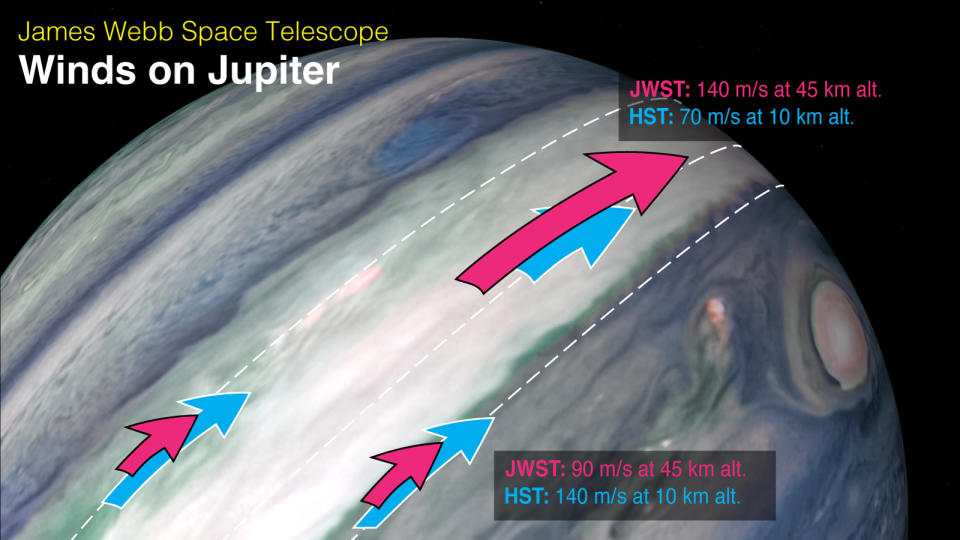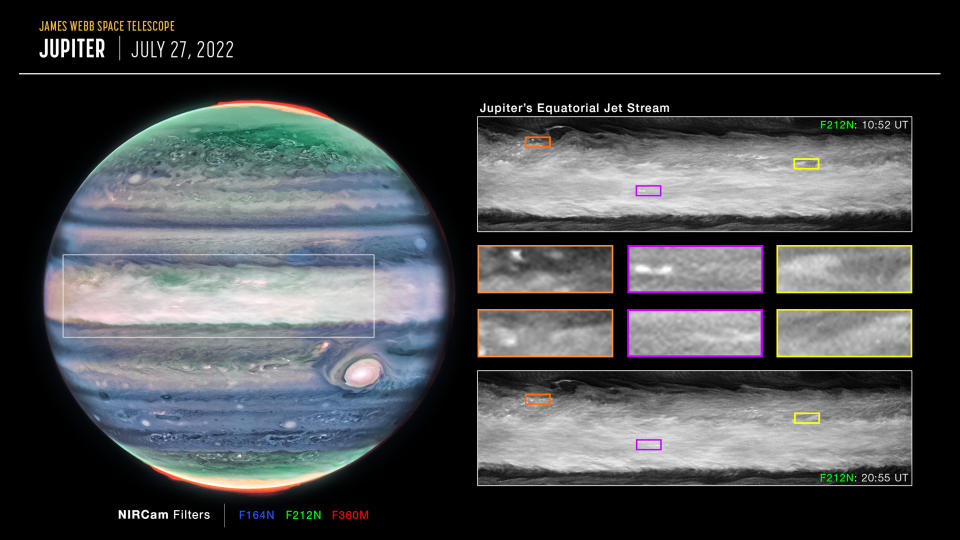Jupiter's immense, intense equatorial jet stream revealed by JWST

Peering closely at the James Webb Space Telescope's fantastic image of Jupiter from July 2022, scientists have spotted a previously unnoticed feature — an immense, fast-moving jet stream flowing around the giant planet's equator.
Jupiter has always been an attractive target for astronomers. Each new telescope, in turn, has been pointed at the giant planet to explore further the active weather in its cloud bands and its enormous anti-cyclonic storm, the Great Red Spot. Even spacecraft such as the Voyagers, Cassini, and New Horizons have snapped their own images of Jupiter during their flybys, and NASA's Juno probe sends back close-up pictures every time it swings around the planet.
So, it was no surprise when astronomers aimed the James Webb Space Telescope in that direction, releasing an amazing high-resolution look at some of the most active weather in our solar system.

This look at the heat released from Jupiter's cloud bands was captured by the infrared cameras on the James Webb Space Telescope in July 2022. Credit: NASA, ESA, Jupiter ERS Team; image processing by Ricardo Hueso (UPV/EHU) and Judy Schmidt
This picture wasn't just to show off JWST's capabilities, though. An international team of scientists poured over the high-resolution details revealed by Webb and compared them with images taken by the Hubble Space Telescope in the days afterward.
Their careful examination turned up a new feature missed by every previous observation: Jupiter has an immense jet stream flowing around its equator.

This infrared image of Jupiter from the James Webb Space Telescope is annotated with arrows showing wind speeds in the planet's upper atmosphere (red) measured by Webb, and winds along the cloud tops (blue) measured by Hubble. The high-altitude jet stream over the equator, detected in JWST's imagery, flows at twice the speed of the cloud tops located 35 km below. Credits: M.H. Wong, UC Berkeley; R. Hueso, University of the Basque Country; NASA; ESA; CSA; STScI; I. de Pater, UC Berkeley; T. Fouchet, Observatory of Paris; L. Fletcher, University of Leicester
READ MORE: Webb's first images spark awe and wonder about the universe
According to the researchers, this previously undetected jet stream measures around 4,800 kilometres across, with wind speeds clocked at over 500 kilometres per hour. By comparison, that is more than ten times the size and roughly twice the speed of a typical jet stream here on Earth.
Additionally, the comparison between Webb's tracking of this jet stream and Hubble's views of the clouds below shows that the jet stream travels at around twice the speed as the cloud tops.
"We knew the different wavelengths of Webb and Hubble would reveal the three-dimensional structure of storm clouds, but we were also able to use the timing of the data to see how rapidly storms develop," Michael Wong of the University of California, Berkeley, who led the Hubble observations, said in a press release.
"This is something that totally surprised us," study co-author Ricardo Hueso of the University of the Basque Country in Bilbao, Spain, added. "What we have always seen as blurred hazes in Jupiter's atmosphere now appear as crisp features that we can track along with the planet's fast rotation and move much faster than the typical velocities found in Jupiter's equator at cloud level."

Several sections of the JWST Jupiter image are highlighted and enlarged here to show regions of strong wind shear (changing wind speed with height) that allowed the researchers to track the equatorial jet stream. Each pair of images shows the same location 10 hours apart, revealing how far the features have moved in that time. Credit: NASA, ESA, CSA, STScI, Ricardo Hueso (UPV), Imke de Pater (UC Berkeley), Thierry Fouchet (Observatory of Paris), Leigh Fletcher (University of Leicester), Michael H. Wong (UC Berkeley), Joseph DePasquale (STScI)
DON'T MISS: Europa's subsurface ocean may be more habitable than we thought
"To me, the exciting thing is that nobody was expecting this narrow, high-speed jet before JWST," Wong said in a Berkeley press release. "We knew there was a narrow jet like this on Saturn, so to discover a similar feature on Jupiter enables new comparative studies of the two giant planets, even if the Jupiter jet turns out to have a different formation mechanism."
Although jet streams had been observed on Jupiter in the past, they were located in mid and high latitudes of the planet and were revealed by the flow of the cloud tops.
This new feature only became apparent due to Webb's resolution and the wavelengths of light that the telescope gathered.
"Since Jupiter is a very bright target for JWST," Hueso wrote in a blog post on the Nature Astronomy site, "the images were acquired in wavelengths in which most of the light is absorbed in its path through the Jovian atmosphere by atmospheric gases such as methane and hydrogen. Thus, the selection of filters used in the observations included some of the wavelengths where the planet is the darkest; meaning that in many of these wavelengths Jupiter had never been observed at enough spatial resolution to resolve the weather systems in the atmosphere."
"Jupiter has a complicated but repeatable pattern of winds and temperatures in its equatorial stratosphere, high above the winds in the clouds and hazes measured at these wavelengths," co-author Leigh Fletcher, of the University of Leicester. said in the Berkeley press release. "If the strength of this new jet is connected to this oscillating stratospheric pattern, we might expect the jet to vary considerably over the next two to four years. It'll be really exciting to test this theory in the years to come."


